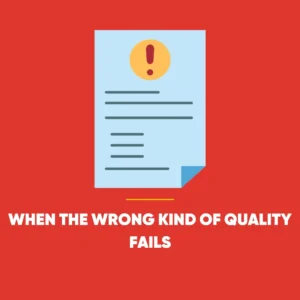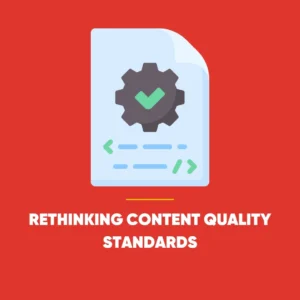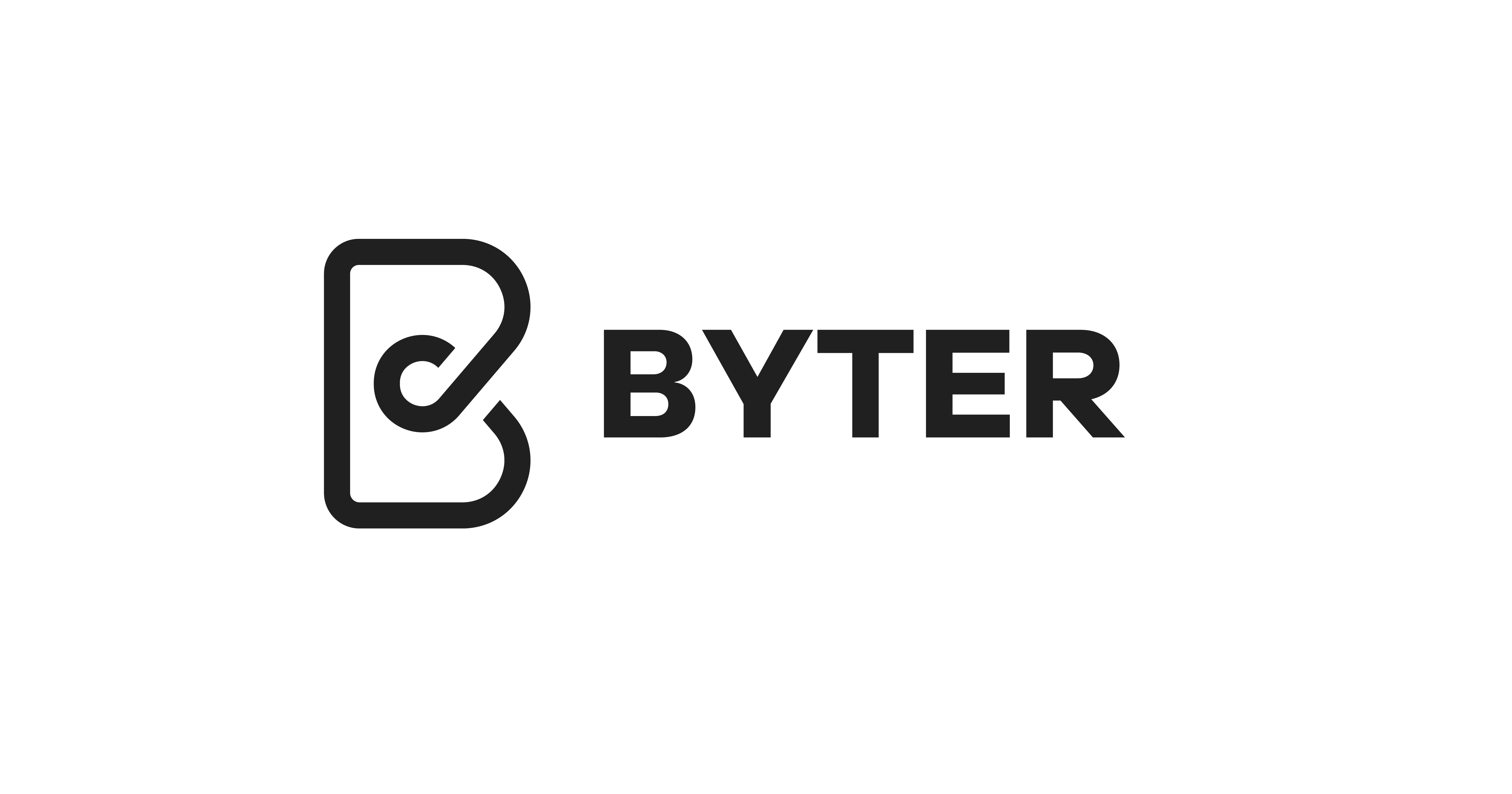Content Quality Standards: When High Standards Hold You Back
Content quality standards are changing fast, pushing marketers to balance creativity, consistency, and purpose across platforms. Yet in practice, what actually performs well online often tells a very different story.
In a fast-moving digital world, clinging to traditional ideas of quality can do more harm than good. What counts as “great content” today depends entirely on context – and that’s precisely where many brands lose their footing.
When Content Quality Standards Don’t Fit New Formats
 Every new communication medium begins with borrowed rules. Early TV producers treated television like radio, filling screens with talking heads. The first websites were little more than static digital brochures.
Every new communication medium begins with borrowed rules. Early TV producers treated television like radio, filling screens with talking heads. The first websites were little more than static digital brochures.
It’s a familiar mistake – applying yesterday’s standards to today’s innovations. Each channel, from YouTube to TikTok to Threads, eventually develops its own unspoken definition of quality. The challenge is, those definitions shift constantly.
Where once great writing looked the same across books, print, and blogs, the internet has fractured that harmony. Today, “quality” can mean something entirely different on each platform. All lowercase captions might signal authenticity on X, while an obviously AI-assisted LinkedIn post can still thrive if the idea resonates.
Marketers must therefore redefine “high quality” not once, but repeatedly – for every channel, every audience, and every purpose.
When the Wrong Kind of Quality Fails
To see this in action, consider TikTok star Addison Rae’s ill-fated appearance on The Tonight Show Starring Jimmy Fallon.
At the height of her fame, Rae performed a medley of trending TikTok dances on live television. On paper, it was flawless: professional lighting, a live band, a studio audience, and a celebrity guest. Yet something felt off. The performance landed awkwardly – polished but soulless.
Why? Because it was high quality by television standards, not by TikTok’s.
TikTok’s appeal lies in its intimacy: hand-held iPhone shots, short vertical clips, casual settings, imperfect lighting. A little chaos is part of its charm. When that raw, relatable style is translated into a slick TV format, it loses what makes it engaging.
In other words, content that feels “high quality” in one context can fall flat in another.
Content Quality Standards Depend on Purpose and Context
The real key to effective content isn’t perfection – it’s alignment.
High quality equals purpose plus context.
- Purpose: What’s the goal? SEO content should drive discovery and conversion. Whitepapers should build credibility with decision-makers. Social posts should entertain or spark engagement. Each goal demands different standards.
- Context: Who’s consuming it, and where? Search users want concise answers. Executives look for authority and data. LinkedIn users prefer authenticity and immediacy.
When both purpose and context are right, the old “rules” of quality become optional. Miss either, and even your most refined content risks irrelevance.
Why One-Size-Fits-All Quality Doesn’t Work
Rigid checklists often fail because strict content quality standards can’t adapt to different tones, formats, and audience expectations.
A perfectly written blog post might underperform against a rougher, conversational video. A heavily designed whitepaper might be ignored if it’s released on the wrong platform. Copying another company’s “best-performing” format can also backfire if the audience’s expectations differ.
Let’s look at how this plays out across three distinct content types.
1. High-Volume SEO or AEO Content
Traditional marketers often dismiss bulk SEO or AEO (Answer Engine Optimisation) content as low quality — short, formulaic, and repetitive. Yet this type of content serves a very specific purpose: answering direct user queries for both humans and search engines.
Its audience isn’t seeking a Pulitzer-level essay; they want quick, relevant information. In this context, clarity and structure matter more than originality or flair.
The true quality lies in execution at scale:
- Refreshing content frequently to stay relevant.
- Covering a wide range of queries and variations.
- Maintaining brand tone without lapsing into AI-generated “fluff.”
Brands creating content for AI-driven search results, like Google’s AI Overviews or Perplexity, must plan strategically. Effective content quality standards focus on the entire programme rather than any single article.
In short, a post that might look simplistic to a writer could be a masterpiece to a search algorithm.
2. Survey-Driven Whitepapers
At the opposite end of the spectrum lies the whitepaper – where polish is non-negotiable.
Here, credibility is the currency. Original research, expert interviews, and professional design aren’t nice-to-haves; they’re essential signals of authority. Enterprise buyers rely on these documents to justify strategic decisions and budget approvals.
A well-executed whitepaper combines meticulous data with elegant storytelling. It’s not meant to go viral – it’s meant to be cited, shared internally, and trusted.
Strong content quality standards ensure excellence, making the time investment worthwhile for building reputation and supporting critical B2B decisions. In this world, a rushed or generic paper would actively damage brand trust.
3. LinkedIn Thought Leadership
Now shift to LinkedIn, where the rules reverse once again.
The platform rewards frequency and authenticity over polish. A founder’s 10-minute hot take about an industry update can outperform a highly edited evergreen post. Why? Because audiences there value immediacy and voice.
Typos, casual punctuation, or lowercase headlines don’t disqualify a post – they often make it feel more human. Regular posting, even when imperfect, builds far greater momentum than waiting weeks to craft the “perfect” update.
LinkedIn’s definition of quality isn’t about flawless prose. It’s about being relevant, real, and present.
Rethinking Content Quality Standards
 At this point, one might assume the takeaway is to lower standards. But it’s quite the opposite.
At this point, one might assume the takeaway is to lower standards. But it’s quite the opposite.
It’s about choosing the right standard. The skill lies in knowing when to demand excellence and when to move fast. Every piece of content has an intended job – and it should be judged by how well it performs that job, not by universal aesthetic ideals.
Obsessing over polish when it doesn’t serve the purpose drains creativity and time. Conversely, cutting corners where authority and trust are crucial can be disastrous.
Quality as a Strategic Choice
Modern marketers must stop treating quality as an absolute and start seeing it as a strategic decision.
Ask before you begin:
- What outcome should this achieve?
- Where will it live and who will see it?
- Which elements matter most in this specific context?
When those answers guide your approach, “good enough” becomes not a compromise, but a competitive advantage.
After all, in content marketing, the smartest brands aren’t those chasing perfection – they’re the ones defining what quality means for their audience, at that moment, in that place.









